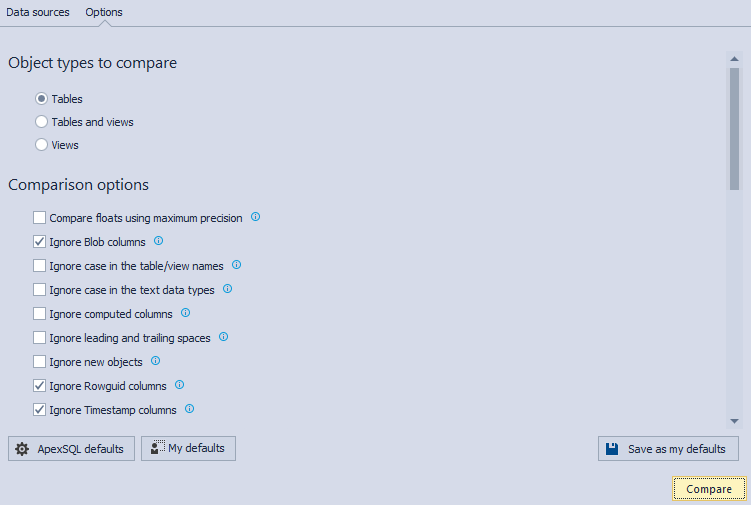Installation
The ApexSQL Data Diff installation wizard is a simple 3-step task.
The first step of installation is welcome screen of the ApexSQL Data Diff wizard:

In this step, users can review the ApexSQL license agreement:

The next installation step allows users to choose installation folder and option for creating a desktop icon:

In the next installation step, the user will be given the option to select one or more hosts e.g. SSMS for add-in integration:

The final step confirms finishing of the installation and allows users to directly run ApexSQL Data Diff from here:

When starting the application, we are greeted with the Project management window that lets us browse through all our recent projects:

ApexSQL Data Diff consists of three main menu tabs:



To start the new comparison, click on the New button located in the Project management window:

We can also do the same by clicking on the New button in the Home tab:

Project window will be shown where we can define what data source types we want to use for the Source and the Destination. We have option of choosing four different data source types:
- Backup
- Database
- Script folder
- Source control
In the Options tab, we can choose between Object types to compare, specific Comparison and Synchronization options, Batching and Optional output elements:

When we expand the Advanced options tab, we have the ability to define additional options. Under the Package tab we have various options for installer package that we can set, such as Compression, Error handling, Optional package information and Logging:
Under the Schema mapping tab, the schema maps of the same name are automatically loaded with the additional ability for the user to create custom schema mapping:
Object filter tab give us the choice to filter specific objects that we want to compare, like Custom comparison key, Row filter, etc. which we can use to narrow a data comparison to affected rows only:
The Object mapping tab will automatically map all of the tables and views with the same names and schemas, but it can also perform custom object mapping:
In the Additional scripts tab, we can create or load pre or post processing scripts that we can later execute before/after the synchronization:
When data sources are selected and all of the options set, we can click the Compare button. The comparison result will be shown in the Results grid:
Located below the Results grid is the Data difference view panel, which shows exact data differences for each compared column of the selected table, and that data differences can be filtered in the independent tabs for All rows/Missing/Different/Additional. Also, we can include or exclude individual rows from the synchronization process:
When we are certain that we have the comparison results that suit our needs, we can click on the Export button, and export the results to HTML simple report, HTML report, CSV data export and Excel report:

By clicking on the Options button in the main window of the application we are greeted with the new Options window, from which we can change options for General and Output tabs. Under the General tab we can define Startup action, Data cache location, Warning dialog, and what theme we want to use:
Under the Output tab we set Output format and editor we want to use, different File location and templates and also what kind of Encoding we want to use for synchronization script:
Once everything is set in the options, we can click on the Synchronize button located in the Home tab of the main application window. Synchronization wizard is divided into three steps, the first step being Synchronization direction which shows us the source and destination we are using along with the type, server and database information:
The second step is Output options, where we can choose Actions we want to perform for synchronization process:
The third and the last step notifies us about Warnings and Actions that we can analyze before the synchronization:
We can save project as a batch file in order to be used for later automatization and scheduling process. By clicking on the Save as batch button located on the bottom-left part of the Synchronization wizard window the Save as batch window opens, that lets us choose different primary and secondary output types along with the preview of the Batch script, Project options and the Additional options that we want to add to the script:
ApexSQL Data Diff along with being the standalone application offers SQL Server Management Studio integration, which once installed, adds the additional option called ApexSQL in the navigation bar of SSMS:

To set the compare parameters from the SQL Server Management Studio, right-click on a database in the Object Explorer → Data compare → Set as source/destination:

When the source or destination is set, the Data sources tab is presented:

We can also select the Options tab which presents us with the same set of options that we have in the standalone application of ApexSQL Data Diff:

After the options are set and data sources selected we can finally click the Compare button located in the bottom-right corner of the window, and the Results grid will be shown in our standalone application.
Resources
Click on the About button under the Resources tab to show the details of the application version:

Under the Get updates window, ApexSQL Data Diff offers user enables for the latest available version of the tool, possibility for checking for updates on start and available patches. Click on the Get updates button under the Resources tab, and ApexSQL Data Diff update window will appear:

December 27, 2017























